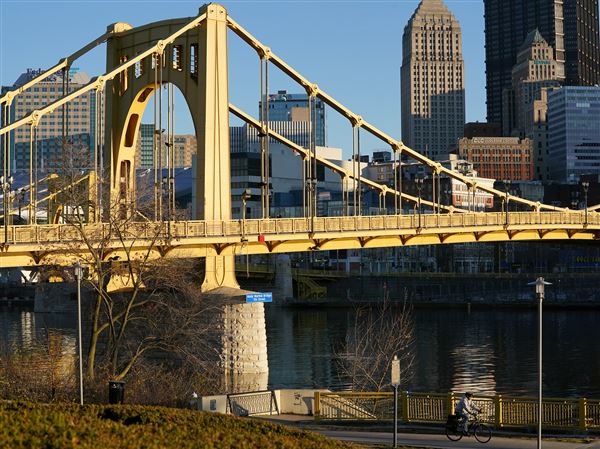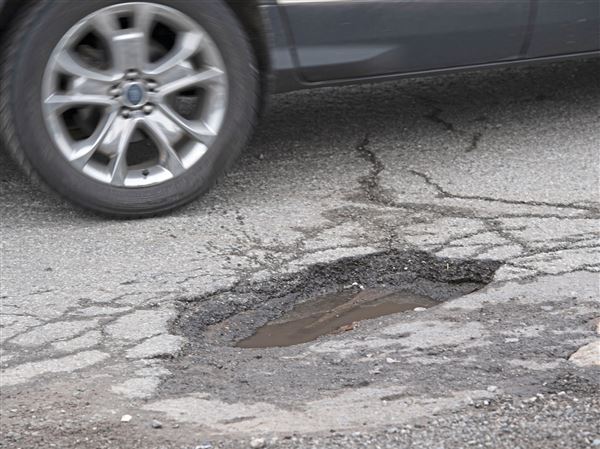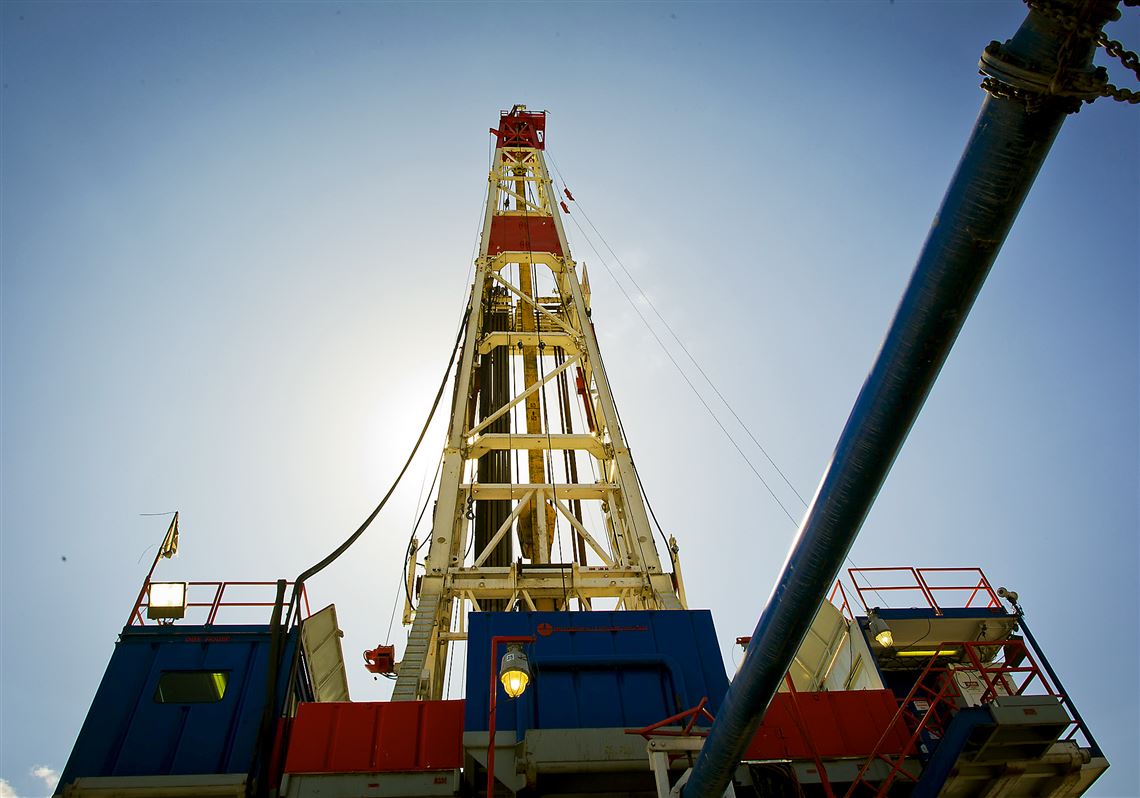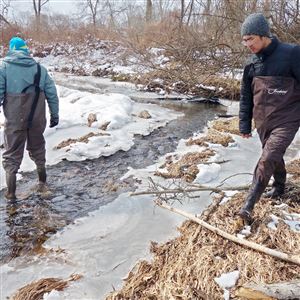Equitrans Midstream Corp. is in the gas pipeline business and a little bit in the water pipeline business.
There are lots of reasons to grow that little bit, promised Thomas Karam, the CEO of the Pittsburgh-based midstream firm.
He was previewing a strategy that he said would be fleshed out later this year to take advantage of shale gas’s extreme thirst for water.
“Produced water services are particularly exciting because the Appalachian Basin needs a solution,” Mr. Karam said in March while announcing a $1 billion deal for control of two Ohio gas pipeline systems.
Produced water is a kind of catch-all term for wastewater that comes back out of a well after chemical-laced frack fluid is pumped into it. Once fracking is over and the well starts producing gas, it also brings to the surface a salty and often radioactive brine that is now mostly trucked around Pennsylvania.
There are at least several hundred miles of produced water pipelines buried in Pennsylvania, but they are largely unregulated and untracked. Environmental regulators say they’ve been hesitant to push for regulations because the pipelines haven’t been known to cause problems and because the technology — both how they’re built and how they’re inspected — has been changing faster than they can regulate.
So for now, Pennsylvania has had a hands-off approach, happy that at least some wastewater trucks are taken off the roads due to pipelines.
Mr. Karam didn’t harp on the reduced truck traffic. Produced water pipelines, he told investors last month, are a juicy business opportunity. They are a service, with predictable product volumes and the potential for long-term contracts, just like gas gathering lines.
“We don't have to re-create the wheel,” he said. “Produced water is piped in other basins, so that what we're going to try to do is introduce that to the Appalachian Basin with similar contractual characteristics.”
It wasn’t clear if Mr. Karam was speaking specifically of buried produced water pipelines. After requesting a list of questions, Equitrans did not respond.
An industry that didn’t
exist five years ago
The water pipeline business is more advanced in the Permian basin in West Texas, where fresh water is more scarce and disposal wells more plentiful — the opposite of Pennsylvania.
Flat topography and warm temperatures make water pipelines easier to build and maintain there. And capital is lining up to finance them.
Wood Mackenzie, an energy consultancy, estimates that more than $1 billion in deals have been struck for water infrastructure in recent years. All that for an industry that didn’t even exist five years ago, said Matthias Bloennigen, director of upstream consulting at the firm.
The money for standalone water midstream companies has graduated from venture capital funding to large private equity firms, he said, with everyone holding their breath for when the first such company will go public. Then they can really see what the market thinks of the produced water handling business.
Pennsylvania isn’t there yet. But judging by the interest in water infrastructure in the region and the plans of companies like Equitrans, could it be far behind?
Already, the state is ahead of others in wastewater recycling — the reuse of frack water from one well site at another.
At a recent shale gas wastewater conference in Pittsburgh, Dawson Hoffman, engineering manager at CNX Resources, wondered how sustainable that will be.
“Water [production] is increasing at a rate that’s really substantial for our industry and we believe there will come a point when we won’t be able to reuse it all and it’ll be a real problem,” Mr. Hoffman said.
CNX has been in front of this trend for years. The company, which used to be part of the coal producer Consol Energy Inc., has laid about 250 miles of plastic water pipelines in the tri-state area since 2010, mostly in Greene and Washington counties.
These high density polyethylene canals route to impoundments and wastewater treatment facilities and have, thus far, “been piecemealed together,” Mr. Dawson said.
But CNX is looking at a more comprehensive approach, which might involve sharing the water pipelines with other oil and gas producers.
No one likes trucks
Anecdotally, the industry and its regulators say produced pipeline leaks happen less frequently than truck spills. Add that to the long list other truck ills, such as traffic, road damage, vehicle crashes and diesel emissions, and “I think pipelines make a lot more sense than trucks in every way,” said Scott Perry, deputy secretary for oil and gas management at the Pennsylvania Department of Environmental Protection.
This view informs why there are currently no regulatory standards for how to build a long-term produced water pipeline in Pennsylvania and no regulatory agency that oversees the integrity of these pipelines if they’re underground. The DEP, as with gas pipelines, is concerned with stream crossings and erosion control during construction and not with the contents of the pipeline. The Pennsylvania Utility Commission also has no oversight in this matter when the lines don’t provide a utility service, which these pipelines do not.
DEP inspectors do come into contact with produced water pipelines, even buried ones, if a spill is reported. The DEP provided three notices of violations sent to operators — two for CNX and one for Seneca Resources for a regulated above-ground line — but conceded there are likely others.
The DEP doesn’t keep track of how many miles of produced water pipelines there are in the state, nor where they’re located. The information may exist in individual permit applications, “but nothing we have tallied or available electronically,” agency spokesman Neil Shader said.
“That’s a legitimate criticism right there,” Mr. Perry said. "That’s something that I think we ought to know.”
But he’s treading carefully.
While Mr. Perry believes the DEP has the legal authority to regulate how these pipelines are constructed and operated, for the past few months he’s been previewing another approach.
“What we are going to pursue first, or perhaps even instead, is a best practices document,” he said.
This would be a set of voluntary guidelines that Mr. Perry hopes the industry would adopt as standard operating procedure.
Guidelines, unlike regulations, could be drafted quickly and changed easily, Mr. Perry said.
“But failure to kind of meet those best practices, in my view, invites regulation,” he warned.
Mr. Perry has had this in the back of his mind since 2015, when Pennsylvania was debating changes to its drilling regulations. The state intended to regulate well development pipelines — temporary lines that supplied water to a well for fracking and would be obsolete after the well was completed. Those pipelines, the regulators agreed, had to be built above ground, inspected frequently, metered, outfitted with automatic shutoff valves, and pressure tested.
After Consol Energy, CNX’s predecessor, mounted a campaign to exclude permanent, buried wastewater pipelines from the regulations, the DEP agreed and indicated it would study the issue further.
“At the time, we just didn’t have the expertise to develop all of the standards for regulation to manage a pipeline network that was going to be in service for many years,” Mr. Perry said.
Plus, the agency didn’t want to stifle the industry in building “this valuable piece of infrastructure,” he said.
Looking back at it now, Mr. Perry said, if the DEP had tried to impose regulations over buried wastewater lines in 2015, they would have been based on now-outdated practices.
There’s also been no rush to regulate because “we’ve really not observed environmental impacts” from these pipelines, Mr. Perry said.
When asked if the lack of visible impact could be due to a lack of tracking, Mr. Perry said it’s possible but unlikely.
“You’re talking about moving a lot of fluid under significant pressure. Little leaks get to be big leaks in a hurry,” he said
“As the CNX one did.”
The big one?
The spill Mr. Perry noted involved a failed valve releasing more than 40 gallons of brine that flowed into a tributary to Dunkard Fork in Greene County in January. DEP inspectors found a dead frog and a dead salamander in the stream, which had conductivity readings more than 10 times higher than a measurement upstream of the release. High conductivity indicates a high concentration of total dissolved solids, such as salts, in the water.
About 1,500 feet of the stream was impacted, the DEP found.
CNX reported a similar situation last month when about 75 barrels of produced water penetrated soil 6 inches deep after an excavator broke a valve on a pipeline in East Finley, Washington County. DEP inspectors did not find impacts to nearby water.
In August 2018, CNX reported that 35 gallons of produced water leaked from a gathering line. About 6 tons of contaminated soil were removed. The company said it was doing more excavation to find the source of the leak in East Finley.
In Indiana County, a leak underground was deduced from an area of muddy ground and no vegetation on a hillside behind a well.
Brian Aiello, a spokesman for CNX, said pipeline spills pale in comparison to dangers of trucks hauling wastewater.
Last year, the company moved 24 million barrels of water — fresh and impaired — through pipelines, which Mr. Aiello said spared roads 1.5 million trucking hours.
The location of the pipelines is submitted to Pennsylvania’s One-Call system, a service that anyone about to dig is supposed to call to find out what’s buried underneath.
Mr. Perry said that the best management guidelines he envisions would probably include “getting locations of these lines and having records of their maintenance programs and inspection programs available to DEP.”
There’s no specific timeline for drafting these best management practices.
“The big challenge, honestly, is we don’t have enough people,” Mr. Perry said.
Anya Litvak: alitvak@post-gazette.com or 412-263-1455.
First Published: April 22, 2019, 11:15 a.m.



















